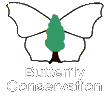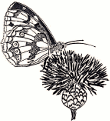At last, the site has finally been officially opened! Numerous supporters were present to witness the Chair of Natural England, Mr Andrew Sells, officially declare the reserve open.

Martin Warren, BC CEO; David Dennis, BC Chair; Sue Smith, BC Glos Branch Chair; Andrew Sells, Chair Natural England (photo Ken Cservenka)
The site was purchased in the spring of 2012 aided by a substantial grant from Natural England so it made good sense for Andrew Sells to cut the ribbon. The purchase was also supported by donations from a number of organisations and private donors and members in order to make this possible. Butterfly Conservation is very grateful to all these people for their generosity.
The site is very special as it supports 33 species of butterfly and nearly 550 species of moth including 38 species of nationally scarce moths, 12 different orchids and a myriad of other typical Cotswold limestone loving plants. Of the 33 species of butterfly, there are currently six species of blue butterfly, namely the Adonis Blue, Chalk Hill Blue, Small Blue, Holly Blue, Common Blue and Brown Argus. There are plans in the future to re-introduce the Large Blue which will make this an exceptionally important site.
As well as being given SSSI status, Natural England has already recognised the diversity of species on this site and has incorporated it into the Cotswolds Commons and Beechwoods National Nature Reserve. This accolade is only kept for special sites and there are only 224 such reserves in England, Scotland, Wales and Northern Ireland. 143 of these NNRs are managed by Natural England to make sure our finest wildlife and geological sites are protected, conserved and enhanced for present and future generations.
Since the purchase a number of works have been carried out on the site both by contractors and volunteers. New fencing, new gates, a car park, improved entrance, scrub clearance, stone walling by the Cotswold Voluntary Wardens, are some of the things which have been done.
The site is grazed by Belted Galloway cattle owned by the National Trust. The usual grazing regime is for up to 12 cattle to be on Rough Bank for approximately two months of the year but this is flexible, depending on the condition of the grassland. Supplementary grazing may be organised at other times of the year if this is felt to be required.
The whole reserve (see map) covers 17.9 ha (44 acres) of which 9.8 ha (24.1 acres) is Rough Bank – the SSSI; the remaining 8.1 ha consists of two smaller fields – Little Myers and Great Myers. These two fields have wet flushes in them which obviously contain different flora and fauna to that found on Rough Bank. These fields are less diverse than the SSSI but are nonetheless important as they can be used for the cattle when they are not on Rough Bank. The same Galloway cattle can also be seen on other National Trust sites locally so may not always be present on this reserve.
We hope, if you visit the site, you will enjoy the experience. It is certainly a very special place. We would ask that you respect the site, keep dogs on a lead and clear up after them, so that others, too, can enjoy the site and follow the Country Code. The car park will be open from 1st April through to 30 September inclusive but at all other times of the year it will be kept locked.
If you are interested in helping with work parties during the months October to March, recording during April to September or any other aspect to do with Butterfly Conservation do please contact us via our contacts page or go to the main Butterfly Conservation website at http://butterfly-conservation.org.










 Internal Pages
Internal Pages

